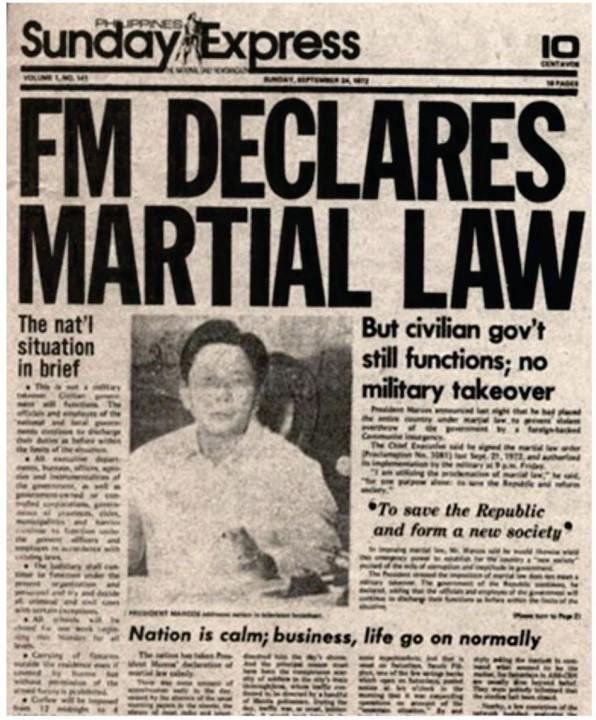A Bit of History: The 1973 Constitution (The Constitution of a Dictator)

There was a time in history that the Republic of the Philippines was under the rule of a dictator. Using the excuse of changing one of the longest constitution of the country and the rising insurgence of communist rebels, Ferdinand E. Marcos manages to end the law to extend his power.
Here's a bit of history of the 1973 Constitution.
The 1973 Constitution
In 1965, Ferdinand E. Marcos was elected president, and in 1967, Philippine Congress passed a resolution calling for a constitutional convention to change the 1935 Constitution.Marcos won the re-election of 1969, in a bid boosted by campaign overspending and use of government funds. Elections of the delegates to the constitutional convention were held on November 20, 1970, and the convention began formally on July 01, 1971, with former President Carlos P. Garcia being elected as convention president. Unfortunately, he died and was succeeded by another former president, Diosdado Macapagal.
Before the convention finished its work, Marcos declared Martial Law, citing a growing communist insurgency as the main reason, which was provided in the 1935 constitution. Some delegates of the ongoing constitutional convention were placed behind bars and others went into hiding or voluntary exile. With Marcos as a dictator, the direction of the constitutional convention turned, with accounts that the president himself dictated some of the provisions of the constitution, manipulating the document to be able to hold into power as long as he could. On November 29,1972, the convention approved its proposed constitution.
The constitution was supposed to introduce a parliamentary-style government, where legislative power was vested in a unicameral National Assembly, with members being elected to a six-years term. The president was to be elected as the symbolic and ceremonial head of state chosen from the members of the national Assembly. The president would serve a six-year term and could be re-elected to an unlimited number of terms.
Executive power was relegated to the Prime Minister, who was also the head of the government and Commander-in-Chief of the Armed Forces who was also to be elected from the National Assembly.
On November 30, 1973, President Marcos issued Presidential Decree No. 73 setting the date of the plebiscite to ratify or reject the proposed constitution. This plebiscite was postponed later since Marcos feared that the public would vote to reject the constitution.
From January 10-15, 1973, Citizen Assemblies were held instead of a plebiscite, where citizens coming together and voting by hand, decided whether to ratify the constitution, suspend the convening of the Interim National Assembly, continue Martial Law or place a moratorium on elections for a period of at least several years.
On January 17,1973, the president issued a proclamation announcing that the proposed constitution had been ratified by an overwhelming vote of the members of the highly irregular Citizen Assemblies.
The constitution was amended several times. In 1976, the Citizen Assemblies, again allowed the continuation of the Martial Law as well as approved the amendments: An Interim Batasang Pambansa to substitute for the Interim National Assembly, the president to also become the Prime Minister and to continue to exercise legislative powers until Martial Law was lifted and authorized the president to legislate on his own on an emergency basis.
In 1980, the retirement age of members of the judiciary was extended to 70 years. In 1981, the parliamentary system was formally modified to a French-style, semi-presidential system where executive power was restored to the president who was, once again to be directly elected; an Executive Committee was to be created, composed of the Prime Minister and 14 others, that served as the president’s Cabinet. In 1984, the Executive Committee was abolished and the position of vice-president was restored.
In 1983, Benigno Aquino Jr., opposition leader and regarded as the most credible alternative to Marcos, was assassinated while under military escort immediately after his return from exile in the United States. The event caused the coming together of the non-violent opposition against the Marcos authoritarian regime, forcing Marcos to hold “snap” elections a year early. The “snap” election was said to be full of fraud and Marcos declared himself winner despite international condemnation and nationwide protests.
A small group of military rebels attempted to stage a coup but failed; however, this triggered what came to be known as the Edsa People Power Revolution of 1986. Under the pressure from the United States of America, who used to support Marcos and his Martial Law, the Marcos family fled into exile. On February 25, 1986, Benigno Aquino Jr.’s widow, Corazon Aquino, was installed as the president.

Yay!
Your post has been boosted with ESTM. Keep up the good work! Install Android, iOS Mobile app or Windows, Mac, Linux Surfer app!
Learn more: https://esteem.app
Join our discord: https://discord.gg/8eHupPq